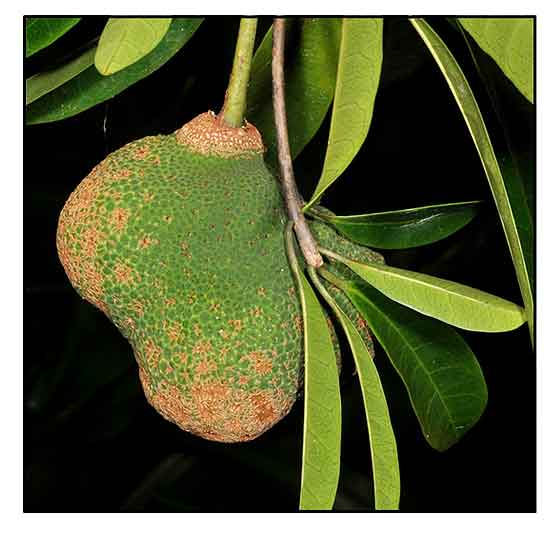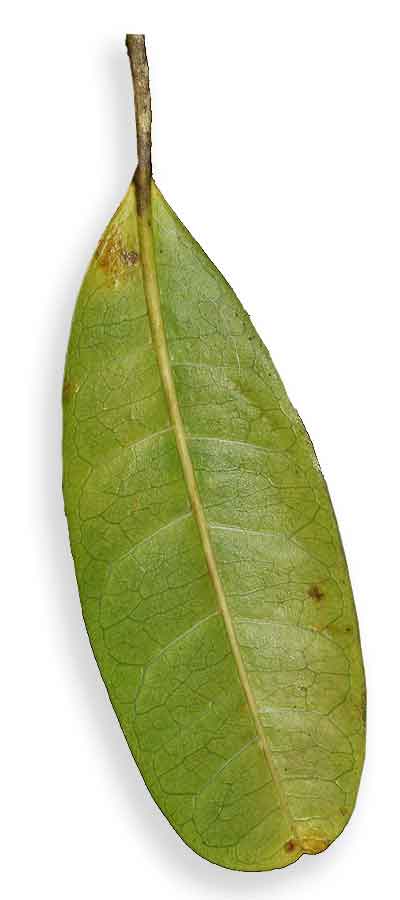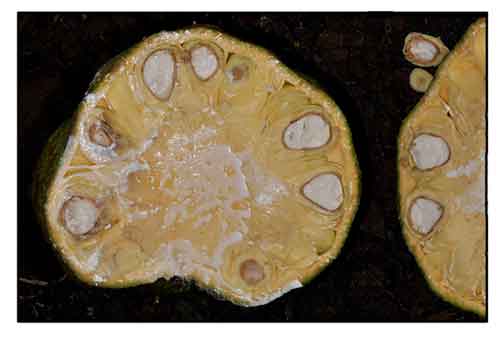
Family • Moraceae
Malanangka
Parartocarpus venenosus (Zoll. & Moritzi) Becc.
PARARTOCARPUS
| Scientific names | Common names |
| Artocarpus cerifer Miq. | Buratu (Philippines) |
| Artocarpus forbesii King | Malanangka (Tagalog) |
| Artocarpus involucratus K.Schum. | Pangi (Tagalog) |
| Artocarpus riedelii Miq. | Parartocarpus (Engl.) |
| Artocarpus tylophyllus (Miq. ) Miq. | |
| Artocarpus venenosus var. tylophyllus Miq. | |
| Artocarpus woodii Merr. | |
| Gymnartocarpus triandra J.J.Sm. | |
| Gymnartocarpus venenosus (Zoll. & Moritzi) Kuntze | |
| Gymnartocarpus woodii (Merr.) Merr. | |
| Parartocarpus beccarianus triandra Baill. | |
| Parartocarpus borneensis Becc. | |
| Parartocarpus excelsus Becc. | |
| Parartocarpus involucratus (K.Schum.) Warb. ex K.Schum. & Laut. | |
| Parartocarpus microcarpus Cprner | |
| Parartocarpus papuanus Becc. | |
| Parartocarpus papuanus S.Moore | |
| Parartocarpus spinulosus Go | |
| Paratocarpus triandrus (J.J.Sm.) J.J.Sm. | |
| Parartocarpus venosus (Zoll. & Moritzi) Becc. | |
| Parartocarpus venosus subsp. forbesii (King) F.M.Jarrett | |
| Parartocarpus woodii (Merr.) Merr. | |
| Saccus forbesii (King) Kuntze | |
| Saccus tylophyllus (Miq.) Kuntze | |
| Saccus venenosus (Zoll. & Moritzi) Becc. | |
| Paratocarpus venenosus (Gaertn.) Voss is an accepted name. KEW: Plants of the World Online | |
| Other vernacular names |
| INDONESIA: Bulu ongko, Purut, Pejetai. |
| MAENGE: Ivo. |
| MALAYSIA: Ara berteh paya. |
| PAPUA NEW GUINEA: Kamansi. |
| THAILAND: Le khaem, Phaya rak lueang. |
| TRADE NAME: Parartocarpus. |
| OTHERS: Pinggi, Minggi, Keledang, Katik, Ara berteh, Upah. |
Botany • Tree up to 35 m tall, sometimes with low buttresses. Leaves spirally arranged; stipules 0.2-0.4 cm long, whitish puberulous, caducous. flowers numerous; processes apiculate to conical, umbonate, 0.5-3 mm high, connate in groups of 2-4 or free, glabrous or minutely puberulous to muriculate; stamens (1 or) 2 (or 3), 6-8 mm long, filaments partly connate or free, anthers 1.5-2.5 mm long, apiculate or not. (Flora Malesiana) Distribution Constituents Studies Availability |
December 2023
![]()
 |
| PHOTOS / ILLUSTRATIONS |
| IMAGE SOURCE: Moraceae : Parartpcarpus venenosus / Abaxial view of leaf / Copyright © 2014 by P B Pelser & J F Barcelona (contact: [email protected]) [ref. DOL82010] / Non-Commercial Use / image modified / click on link or image to go to source page / Phytoimages.siu.edu |
| OTHER IMAGE SOURCE: Moraceae : Parartpcarpus venenosus / Fruit / Copyright © 2014 by P B Pelser & J F Barcelona (contact: [email protected]) [ref. DOL82012] / Non-Commercial Use / image modified / click on link or image to go to source page / Phytoimages.siu.edu |
| OTHER IMAGE SOURCE: Moraceae : Parartpcarpus venenosus / Longitudinal section of fruit / det. John Rey Callado / Copyright © 2012 by P B Pelser & J F Barcelona (contact: [email protected]) [ref. DOL47112] / Non-Commercial Use / image modified / click on link or image to go to source page / Phytoimages.siu.edu |
Additional
Sources and Suggested Readings |
• |
DOI: It is not uncommon for links on studies/sources to change. Copying and pasting the information on the search window or using the DOI (if available) will often redirect to the new link page. (Citing and Using a (DOI) Digital Object Identifier) |
| List of Understudied Philippine Medicinal Plants |
| New plant names needed The compilation now numbers over 1,300 medicinal plants. While I believe there are hundreds more that can be added to the collection, they are becoming more difficult to find. If you have a plant to suggest for inclusion, native or introduced, please email the info: scientific name (most helpful), local plant name (if known), any known folkloric medicinal use, and, if possible, a photo. Your help will be greatly appreciated. |
• |
 |




